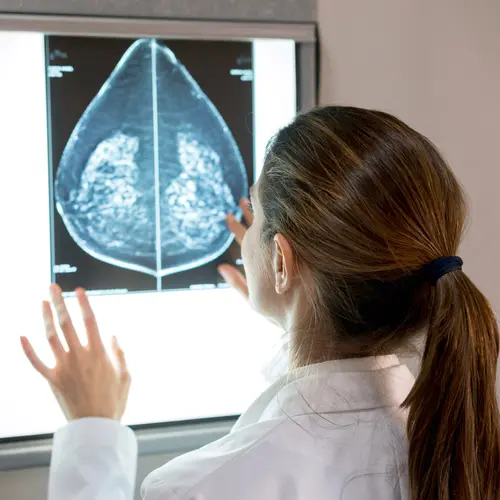What Is a Fibrocystic Breast?
Fibrocystic breast changes are two things that can happen naturally in your breasts: fibrous tissue and benign (non-cancerous) cysts. It can happen when a woman gets thicker breast tissue that they can feel through the skin. Sometimes, cysts also form.
This is a very common condition. When you touch your breasts, you may notice that they feel lumpy or rope-like. They may also feel swollen or tender, especially in the outer, upper parts.
Fibrocystic Breast Symptoms
“Fibrosis” means you have a lot of breast tissue that’s scar-like. It feels firm or rubbery. A cyst is a fluid-filled lump or sac that can move around in your breasts. If fluid builds up, it can stretch the surrounding tissue. It’s not harmful, but it can hurt.
Aside from a difference in the way your breast tissue feels, you might notice:
Changes that are similar in both breasts
Dark brown or green discharge from your nipples
Lumps that change size during your menstrual cycle and may move under your fingers
General breast tenderness or pain, especially before your period
Pain or discomfort under your arms
Breasts that feel full, swollen, or heavy
Fibrocystic Breast Causes and Risk Factors
About half of women in their 20s to 50s will have fibrocystic breast changes. It’s rare after menopause, but it can happen if you’re using hormone therapy.
This means hormones like estrogen might play a role, since they affect breast tissue. But doctors aren’t exactly sure what causes these changes. Drinking alcohol may make them more likely, especially in women ages 18 to 22.
The condition used to be known as fibrocystic breast disease. But because it’s a normal part of life for many women, and not really a disease, medical professionals now call them “changes.”
Is it Cancer?
No. Fibrocystic breast changes aren’t harmful. And your chances of getting cancer don’t increase because you have them.
But it can make it tricky to feel for new lumps or changes in your breasts when you do self-exams. That’s why you really need to know what’s normal for your breasts. When you notice something different, have your doctor check it out right away.
Fibrocystic Breast Changes Diagnosis
Your medical appointment may include:
Clinical breast exam.Your doctor will look at and feel your breasts and the lymph nodes in your lower neck and under your arm. If the changes seem normal, you may not need any more tests. Or you may come back a few weeks later after your period for another exam.
Mammogram.If your doctor wants more information about a lump or thick breast tissue, you may have a mammogram. This is a type of X-ray that looks at an area of concern in your breast. The radiologist who looks at the image will focus on that area.
Ultrasound.This test uses sound waves to make an image of your breasts. You may have it at the same time as a mammogram or, if you’re under 30, instead of a mammogram. Ultrasounds are better at testing dense breast tissue in young women.
Fine-needle aspiration.If a lump feels like a cyst, your doctor may try to remove fluid from it. Sometimes, this can also collapse the cyst and end the discomfort.
Breast biopsy. If your doctor needs more information to decide, they’ll do a biopsy. This means getting a sample of your breast tissue. It’s usually done in an office or clinic with a needle. Some women need surgery. The biopsy will show if a lump is a cyst or solid. It’ll also tell your doctor if the growth is cancerous.
Fibrocystic Breast Changes Treatment and Home Remedies
You usually won’t need treatment unless your doctor finds cancer. If it’s a cyst, your doctor can puncture and drain it. This can lessen pain and pressure, but the fluid may come back. Sometimes, cysts go away on their own.
Some women find relief by limiting caffeine. This is found in coffee, tea, chocolate, and sodas. Studies haven’t found proof of a link, but if you have fibrocystic breasts, you might try cutting back to see if it helps.
Your doctor may also recommend minor lifestyle changes to help your symptoms, such as:
Cut salt from your diet to help reduce breast swelling at the end of your menstrual cycle.
Take a diuretic, a drug that helps drain fluid from your body.
Ask your doctor before taking any vitamin or herb supplements that claim to help symptoms. They can have side effects.
Some doctors treat severe cases with prescription hormones like birth control pills or tamoxifen, a drug most often used to treat breast cancer. These can have serious side effects, too.
Fibrocystic breast changes can be painful. Try these tips to ease discomfort:
Avoid contact sports and activities that could affect your breasts.
Wear a sports bra when you exercise, especially when your breasts feel extra sensitive. It may also help to sleep in one.
Put heat or ice on painful areas.
Take an over-the-counter anti-inflammatory drug like ibuprofen.
Wear a good-quality, supportive bra that fits well.
Lower the amount of fat in your diet.

